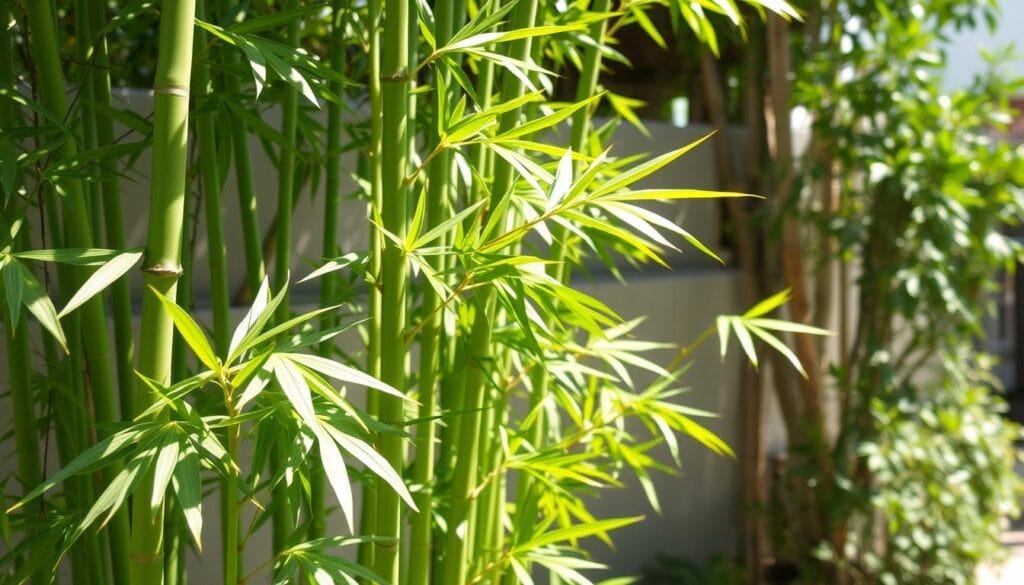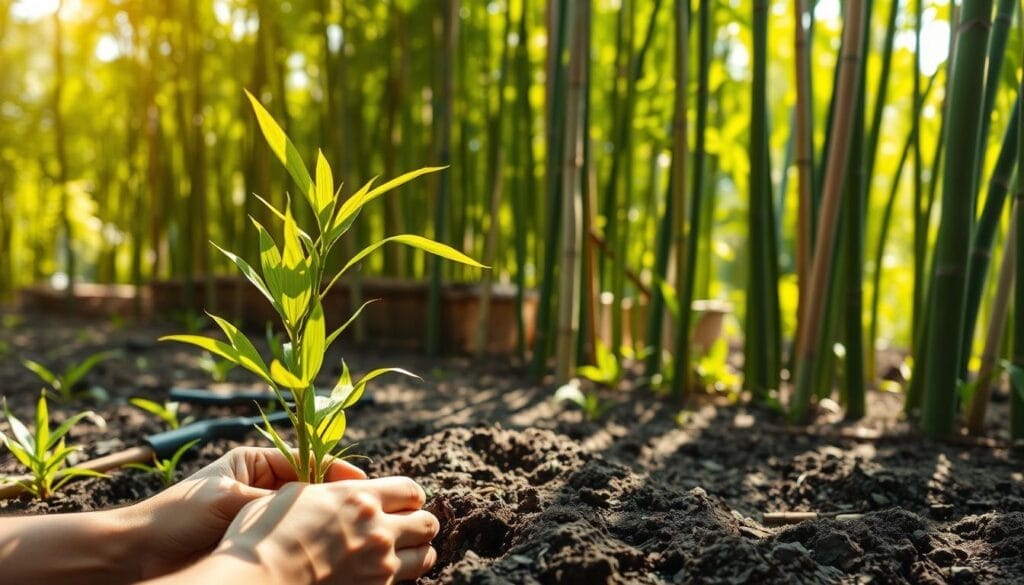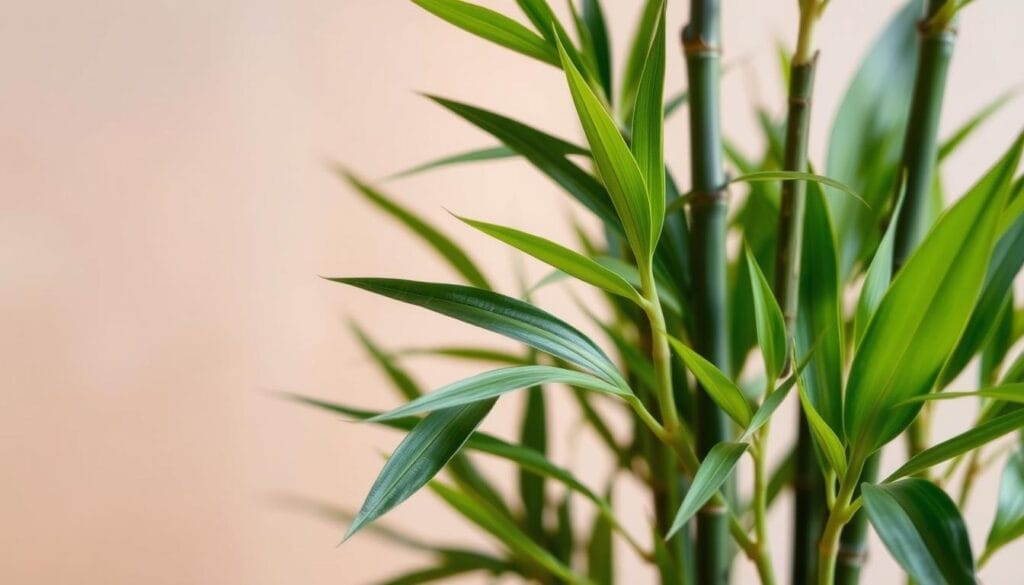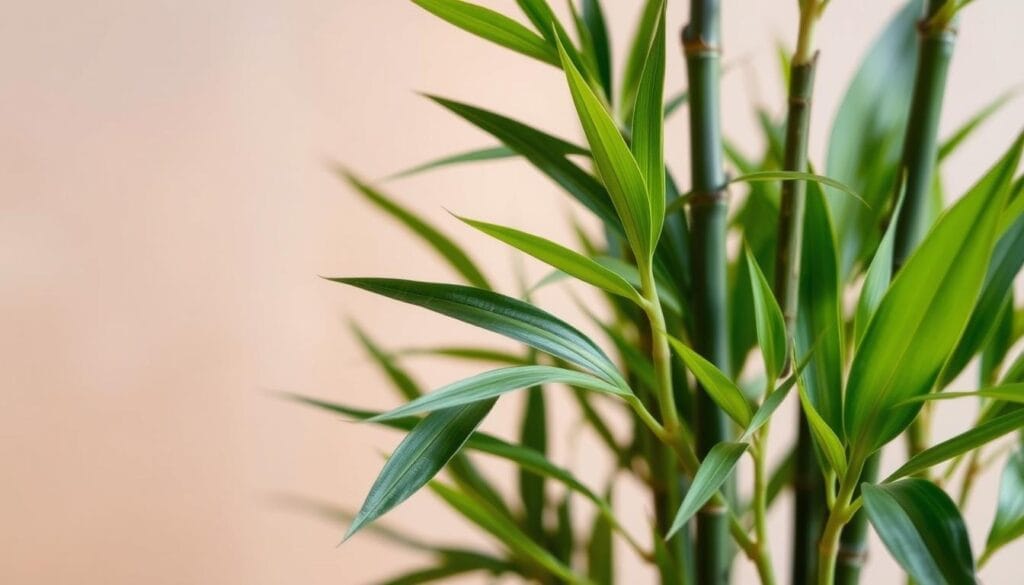Top Bamboo Plants for Your Home Garden 2025
Top Bamboo Plants for Your Home Garden 2025
Imagine a peaceful oasis in your backyard. It’s filled with nature’s sounds and bamboo plants gently swaying. Many homeowners can make this dream come true by learning how to grow bamboo indoors and outdoors. Bamboo plants are not just beautiful; they also clean the air and reduce noise.
An idyllic bamboo garden in the morning light, with lush, verdant stalks swaying gently in a calm breeze. The foreground features a cluster of thick, woody bamboo trunks, their intricate segmented patterns casting soft shadows on the ground. In the middle ground, delicate bamboo fronds sway, their slender leaves catching the warm, golden sunlight. The background is filled with a verdant, tranquil landscape, with a hint of a serene pond or stream reflecting the surrounding foliage. The overall scene conveys a sense of natural harmony and relaxation, perfectly capturing the meaning and benefits of bamboo plants for the eco guider’s home garden.
Adding bamboo plants to your garden creates a calm space. It’s perfect for relaxation and well-being. Bamboo plants are easy to care for and can grow well in many places. They’re ideal for those who want greenery without a lot of work.

Whether you grow bamboo inside or outside, it brings many benefits. It helps prevent soil erosion and supports local wildlife. So, adding bamboo plants to your garden is a smart choice.
Key Takeaways
- Adding bamboo plants to your home garden can create a peaceful and serene atmosphere
- Bamboo plants are low-maintenance and can thrive in a variety of environments
- They provide a range of benefits, including air purification and noise reduction
- Bamboo plants can help prevent soil erosion and support local biodiversity
- With the right guidance, you can learn how to grow bamboo indoors and outdoors
- They are a great option for homeowners looking for the best bamboo plants for their home garden
Understanding the Cultural Significance of Bamboo
Bamboo has been important to humans for thousands of years. It’s more than just a useful plant. In many Asian cultures, bamboo means good luck, wealth, and long life. Knowing about types of bamboo for home gardens helps us see the value of adding them to our yards.
Looking after bamboo plants needs special care. Bamboo plant care tips differ by type. Yet, bamboo’s cultural importance stays the same across cultures. Today, bamboo is used in gardens to add peace and calm. It helps make the garden feel balanced and peaceful.
- Symbolism: Bamboo is often seen as a symbol of strength, flexibility, and resilience.
- Feng Shui: Bamboo is believed to bring balance and harmony to the environment, and its placement is carefully considered in Feng Shui principles.
- Cultural heritage: Bamboo has been an integral part of many Asian cultures for centuries, and its significance is celebrated today.
By knowing bamboo’s cultural value and following bamboo plant care tips, gardeners can make a peaceful outdoor space. This space shows the beauty and grace of bamboo.
Bamboo Plants for Your Home Garden: Essential Guide
Choosing the right bamboo plant for your home garden involves several key factors. Climate, soil type, and space are all important. With many indoor bamboo varieties, knowing their needs is vital for their growth.
To keep your bamboo plant healthy, regular care is needed. This includes watering, fertilizing, and pruning. Here are some tips to help:
- Watering: Bamboo plants need consistent moisture, most in the first year.
- Fertilizing: Use a balanced fertilizer during the growing season.
- Pruning: Regular pruning keeps the plant’s shape and promotes growth.
By picking the right bamboo and caring for it, you’ll enjoy its benefits. Whether you want something easy to care for or a standout piece, there’s a bamboo for you.https://www.youtube.com/embed/QOFoubXF7EY
Popular Bamboo Species for Home Gardens
Choosing the right bamboo species for your home garden is key. There are many options, each with its own benefits. By picking the right one, you can enjoy the perks of bamboo indoors and outdoors.
Popular species include running, clumping, and dwarf bamboo. Each has its own growth pattern and needs. For example, running bamboo grows fast but can spread. Clumping bamboo is more compact and easier to handle. Dwarf bamboo is great for small spaces and pots.
Here are some key characteristics of each species:
- Running Bamboo: fast-growing, invasive, and ideal for large spaces
- Clumping Bamboo: compact, non-invasive, and suitable for small gardens
- Dwarf Bamboo: compact, low-maintenance, and perfect for indoor containers
Knowing the differences between species helps you pick the best one for your garden. Bamboo offers many benefits like purifying the air and reducing noise. With the right care, you can enjoy bamboo’s beauty and benefits in your garden.
Selecting the Perfect Location for Your Bamboo
Choosing the right spot for your bamboo plant is important. Sunlight, soil type, and wind protection are key factors. Most bamboo needs partial shade to full sun. The soil’s type and pH also matter for your plant’s health.
It’s vital to pick the right bamboo for your climate and soil. You can find many varieties at local nurseries or online. A good supplier can offer advice on care and help you choose the best bamboo for you.

A lush, verdant bamboo plant thriving in a sunlit, sheltered corner of a private garden. The vibrant green canes sway gently in a soft breeze, their delicate leaves rustling in a serene, natural harmony. The scene is captured through the lens of an eco guider, showcasing the ideal location for this resilient and low-maintenance plant – a tranquil spot protected from harsh winds, with ample indirect sunlight to nourish its growth. The overall atmosphere evokes a sense of calming tranquility, perfectly complementing the “Selecting the Perfect Location for Your Bamboo” section of the article “Bamboo Plants for Your Home Garden: Meaning and Benefits”.
- Soil moisture and drainage
- Wind protection and support
- Proximity to other plants and structures
By carefully choosing a location, you can ensure your bamboo thrives. With proper care, your bamboo will bring beauty and joy for years.
Essential Tools and Materials for Bamboo Cultivation
To keep your bamboo plants healthy, you need the right tools and materials. This includes quality soil, containment systems, and watering gear. These help your bamboo plants grow well and live long.
When caring for bamboo, think about their natural home. This means the right soil, a good place to grow, and enough water. Choosing the right bamboo for your area is also key. Different bamboos need different things.
- High-quality soil with good drainage
- A suitable containment system, such as a bamboo barrier
- A watering can or hose with a spray nozzle
- Fertilizers specially made for bamboo plants
With these tools and materials, you can give your bamboo plants the care they need. This way, they can grow strong and healthy.
Step-by-Step Planting Guide
Learning how to grow bamboo indoors starts with picking the right types of bamboo for home gardens. With the right care, you can bring the beauty of bamboo into your home. Begin by preparing the soil with organic matter and fertilizers.
A good potting mix is key for bamboo to thrive. Adding mulch helps keep moisture in and weeds out. Make sure your pot is big enough, at least 12-18 inches deep, for the bamboo’s growth.

A lush, verdant bamboo garden, bathed in soft, natural light. In the foreground, a gardener’s hands carefully planting a young bamboo shoot, its leaves unfurling with vibrant green hues. The mid-ground showcases the step-by-step process, with tools and soil at the ready. In the background, mature bamboo stalks sway gently, their slender, towering silhouettes casting long shadows. This eco guider image captures the tranquil essence of bamboo planting, inviting the viewer to discover the meaning and benefits of these versatile plants for the home garden.
- Plant the bamboo rhizome 1-2 inches below the soil surface
- Water thoroughly and keep the soil consistently moist
- Fertilize regularly with a balanced fertilizer
By following these steps and giving your bamboo the right care, you can enjoy its beauty in your home garden.
Indoor Bamboo Growing Techniques
Growing bamboo indoors requires careful attention to ensure the plant thrives. There are many indoor bamboo varieties, each with its own needs. Regular watering, fertilizing, and pruning are key to keeping your bamboo healthy. These actions help your plant purify the air and act as a natural screen.
The Seabreeze and Blue Haven are popular for their hardiness and ease of care. To help your bamboo grow well, it needs the right light and temperature. Here are some important tips for growing bamboo indoors:
- Lighting: Most indoor bamboo varieties need bright, indirect light to grow.
- Temperature: Bamboo prefers temperatures between 65-75°F (18-24°C) during the day and no lower than 55°F (13°C) at night.
- Humidity: Keeping the air humid, around 50-60% relative humidity, is important for bamboo growth.
By following these indoor bamboo growing tips, you can enjoy the benefits of a healthy bamboo plant at home. Keeping up with regular maintenance is key to avoiding pests and diseases. This ensures your bamboo stays healthy and continues to thrive.
| Indoor Bamboo Variety | Lighting Requirements | Temperature Range |
|---|---|---|
| Seabreeze | Bright, indirect light | 65-75°F (18-24°C) |
| Blue Haven | Medium to bright light | 65-75°F (18-24°C) |
Maintaining Healthy Bamboo Plants
To keep your bamboo plants thriving, follow proper bamboo plant care tips. This means regular watering, fertilizing, and pruning. These steps help prevent common health issues in your plants. When picking the right bamboo for your garden, think about the climate, soil, and space.
There are many bamboo varieties for gardens to pick from. Each has its own needs and looks. Some popular ones are clumping, running, and dwarf bamboo. No matter your choice, ensure it gets the right conditions to grow. Here are some important tips:
- Water your bamboo plants regularly, but avoid overwatering
- Fertilize your plants during the growing season to promote healthy growth
- Prune your plants regularly to maintain their shape and prevent them from becoming too dense
By following these tips and choosing the right bamboo varieties for gardens, you’ll enjoy their beauty and air-purifying benefits. Always remember to follow proper bamboo plant care tips for your plants’ health and longevity.

a detailed macro view of a healthy bamboo plant with lush green leaves, depicting the care and maintenance required to grow it successfully in a home garden setting. the plant is placed against a soft, diffused background with warm, gentle lighting that enhances the plant’s natural beauty and texture. the scene is captured through the lens of an eco guider camera, emphasizing the natural, eco-friendly approach to bamboo cultivation.
Troubleshooting Common Bamboo Problems
Growing bamboo at home can face issues like disease, pests, and growth problems. Regular care and maintenance are key to avoiding these. Knowing the causes and symptoms of common problems helps gardeners prevent and solve them. This ensures the health and success of bamboo plants.
Common issues include disease from too much moisture and pests like insects eating leaves and stems. To avoid these, it’s important to provide the right sunlight, water, and nutrients. Growing bamboo requires careful attention and regular upkeep.
- Monitor your plants regularly for signs of disease or pests
- Adjust your watering and fertilization schedule as needed
- Prune your plants to maintain their shape and promote healthy growth
By following these tips and staying alert, you can prevent common problems. This helps keep your bamboo plants healthy and thriving.
Environmental Benefits of Growing Bamboo
Growing bamboo can greatly help the environment. One big benefit of bamboo plant benefits is it cuts down on carbon footprint. Bamboo is very renewable and takes in more carbon dioxide and makes more oxygen than many plants. This makes it a great pick for gardeners wanting a greener space.
Bamboo also stops soil erosion. Its wide roots keep the soil in place, lowering the chance of landslides and erosion. This is why bamboo is perfect for gardens with steep slopes or where soil erosion is common.
Some main environmental perks of growing bamboo are:
- Carbon footprint reduction
- Soil erosion prevention
- Biodiversity support
- Air purification
- Noise reduction

An eco guider bamboo plant growing in a lush, serene garden. The plant’s tall, slender green stalks sway gently in a soft breeze, their leaves rustling in a calming rhythm. Sunlight filters through the canopy, casting a warm, natural glow on the scene. In the foreground, the bamboo’s intricate root system is visible, representing its strong, stabilizing presence. The background features a tranquil pond, reflecting the bamboo’s verdant hues. An atmosphere of harmony and environmental balance pervades the image, showcasing the benefits of incorporating bamboo into a home garden.
By growing bamboo, gardeners help make their environment more sustainable. With its many bamboo plant benefits, indoor bamboo plants, and bamboo varieties for gardens, bamboo is getting more popular in home gardens.
Harvesting and Using Bamboo
Harvesting and using bamboo requires the right methods for cutting and processing. Selecting the right bamboo plant is key, as different species have different uses and needs. You can find bamboo plants for sale online or at local gardening stores.
After getting your bamboo plant, it’s important to care for it properly. This means giving it the right amount of water, sunlight, and nutrients. With good care, bamboo can be used in many ways, like crafts, construction, and landscaping. Some common uses include:
- Building materials, such as flooring and fencing
- Crafts, such as basket weaving and woodcarving
- Landscaping, such as hedges and ornamental features
For creative projects with bamboo, there are many resources online, like tutorials and workshops. By using the right harvesting and processing techniques, you can enjoy bamboo’s benefits. These include its sustainability, durability, and unique look.
Conclusion: Creating Your Bamboo Paradise
Adding bamboo plants for your home garden can turn your outdoor area into a serene, green haven. By picking the best bamboo plants and following our guide, you can grow bamboo indoors successfully. This will bring you many benefits.
Bamboo is not just a plant; it’s a symbol of culture and nature’s power. With the right care, you can make your own bamboo paradise. It will be full of greenery, beauty, and good for the planet. Let bamboo make your outdoor space even better.
FAQ
What are the benefits of adding bamboo plants to my home garden?
Bamboo plants purify the air and reduce noise. They also prevent soil erosion. Plus, they make your garden look beautiful and peaceful.
What are the different types of bamboo plants available for home gardens?
Home gardens can have running, clumping, or dwarf bamboo. Each type has its own look and benefits. Pick the one that fits your garden and climate best.
How do I select the perfect location for my bamboo plant?
Choosing the right spot for your bamboo is key. Think about sunlight, soil, and wind. Make sure it has enough room to grow.
What tools and materials do I need for bamboo cultivation?
You’ll need tools for soil, containment, watering, and fertilizing. The right tools help your bamboo grow strong and healthy.
How do I care for my bamboo plant?
Caring for bamboo means watering, fertilizing, and pruning. Know the specific needs of your bamboo. Watch for diseases and pests too.
Can I grow bamboo indoors?
Yes, you can grow bamboo indoors. But, you need to think about light, temperature, and humidity. Choose the right indoor bamboo and provide the right conditions.
What are the environmental benefits of growing bamboo?
Bamboo helps the environment by reducing carbon, preventing erosion, and supporting wildlife. Growing bamboo makes your garden more eco-friendly.
How do I harvest and use my bamboo plant?
Harvesting bamboo means cutting and processing it right. You can use it for crafts, building, or landscaping. Learning how to use your bamboo can be rewarding.

2 Comments